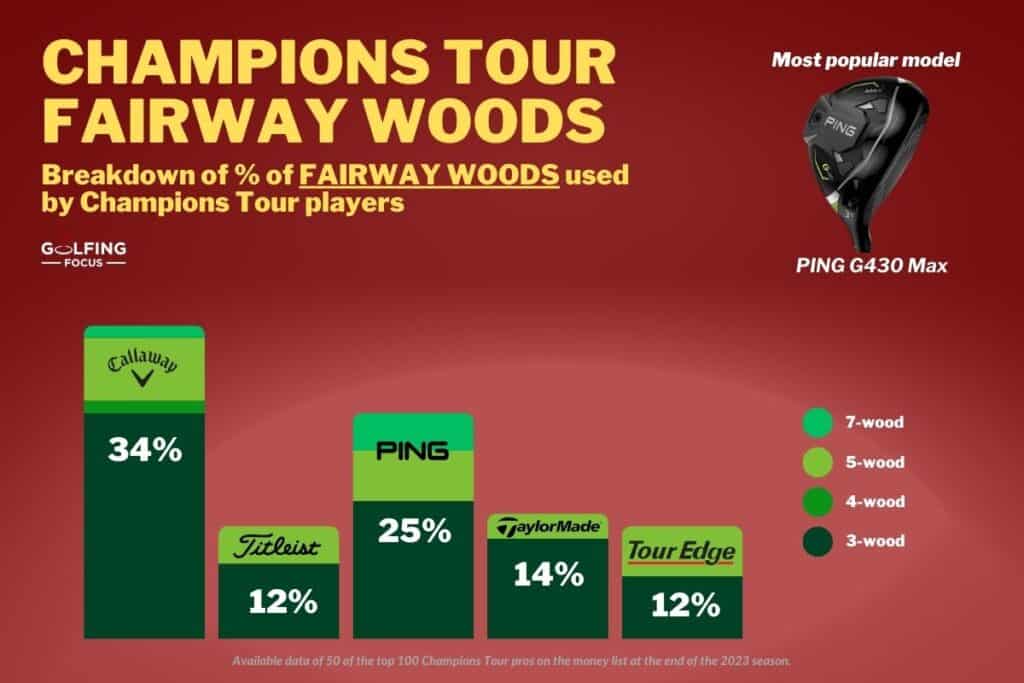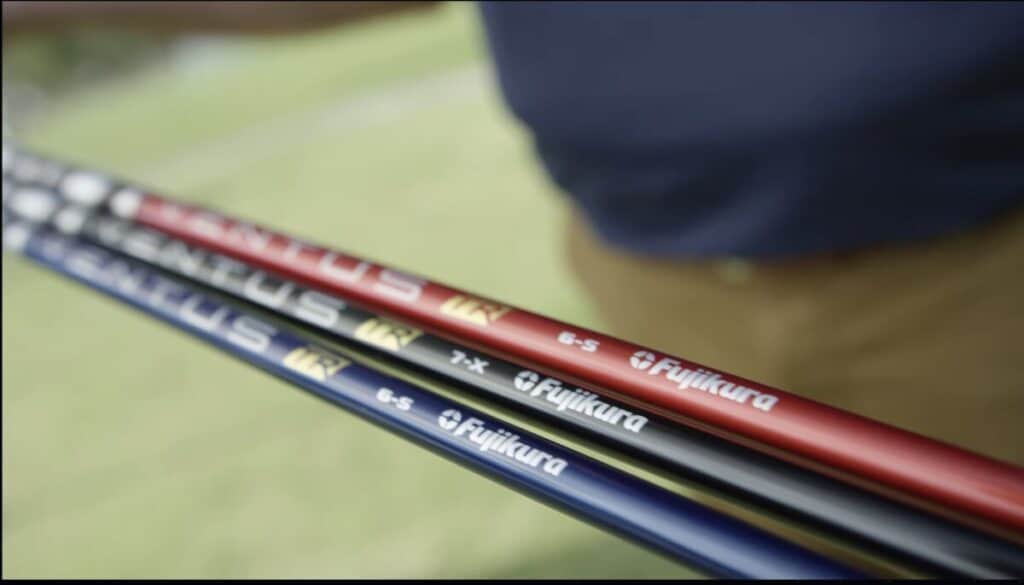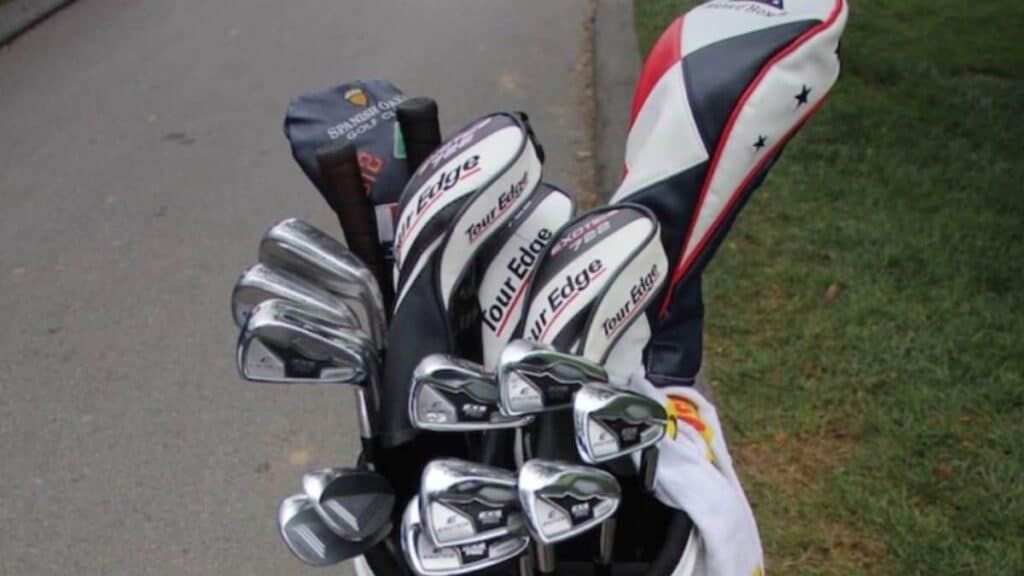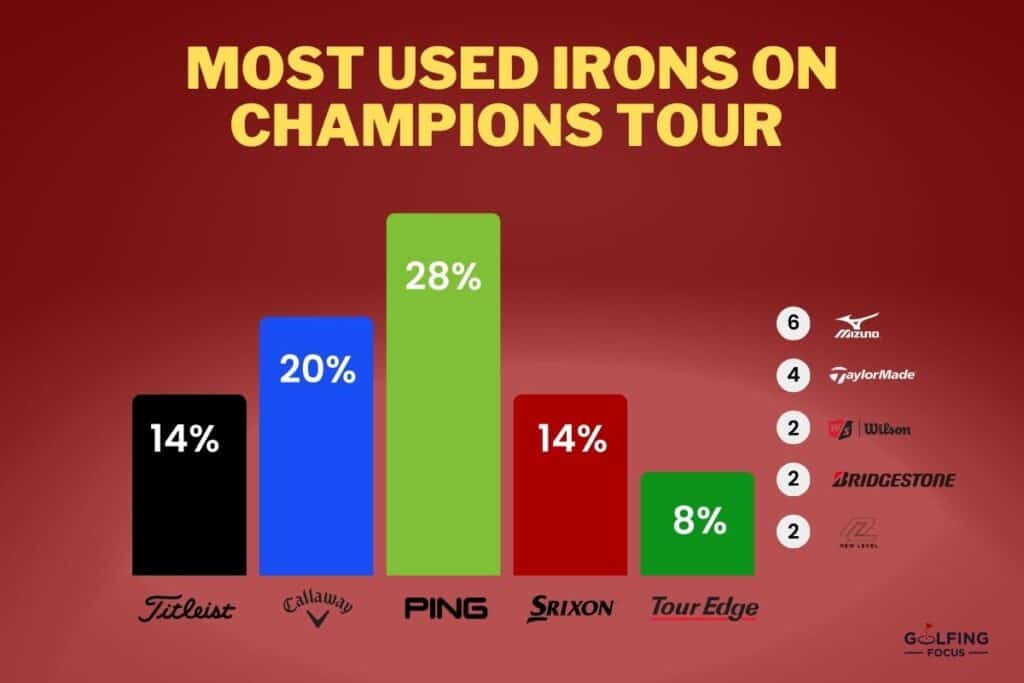How Much Does Driver Loft Affect Distance? Loft is Dynamic Too!

To get the most distance with your driver one of the key things you must do is to get the ball up in the air as quickly as possible.
And although your driver has the lowest loft of all the clubs you use to get to the green it still has some degrees of loft on it to help you do just that.
As a result driver loft clearly has a material effect on the distance you are able to get off the tee but to understand how much driver loft impacts how far you hit the ball we need to look beyond the loft number that is actually stamped on it.
As a whole ‘dynamic’ loft – the driver loft at impact – affects distance more than ‘static’ loft – the number shown on the club. Dynamic loft is affected by many aspects of a golfer’s swing and according to Trackman an increase of 4.2º of dynamic loft can result in a 29-yard longer drive for a 95mph swingspeed golfer.
The stats that launch monitor manufacturers such as Trackman have given golfers of all standards to help them understand why they hit the ball as far as they do have undoubtedly resulted in a step change in our understanding of driver distance.
Their ever-increasing use has therefore obviously been a great thing.
But if you are anything like me they can also sometimes make an already complicated game seem even more so.
For example when it used to come to discussions about driver loft and how it affected distance I assumed until relatively recently that the main thing that mattered was the loft number that was displayed on the club.
The reality however is a bit more complex than that and to truly understand how much driver loft impacts distance, and whether a higher or lower loft of driver, will result in you hitting the ball further we must delve a bit deeper to understand that driver loft is not just ‘static’ but also ‘dynamic’.
There’s also an element of ‘spin loft’ in there too but while it may seem initially a bit overly complicated, if you spend a little time trying to get to know what these terms mean in practice it can help you choose the correct degree of driver that gets you some vital extra yards out on the course.
Because while it may seem a bit illogical at first it may mean that for some players it is better to have a higher loft on their driver to get more distance while for others it will mean lowering the loft because of the way they hit the ball.

Does a Higher or Lower Loft Driver Go Further?
When it comes to the question of whether adding or lowering the loft on your driver will increase the distance you hit the ball the answer would seem to be obvious.
You use drivers off the tee to try and hit the ball as far as you can and you hit shorter and shorter clubs with more and more loft as you get closer to the green because they don’t go as far as a result of being more lofted.
So if you want to drive the ball further and increase distance surely you just need to keep lowering the loft of the driver you use?
As a general rule golfers with slow swingspeeds of 80mph or less and those who hit up on the ball with a positive attack angle increase distance by using a higher loft driver. Player’s that hit down on the ball with a negative attack angle or those with high driver 100mph+ swingspeeds benefit from lower driver lofts.
As with every rule of thumb in golf however there are of course many exceptions but what we are trying to establish quickly when it comes to the topic of whether increasing or decreasing the loft on a driver will add or reduce distance is that loft is three rather than a two-dimensional.
The loft stamped on your driver – whether that be 7º or 14º – is only one element of the picture when it comes to driver loft.
As we can see from an example of Rory McIlroy’s launch monitor data below, loft is also ‘dynamic’ and dynamic loft is controlled rotationally rather than in the up-and-down direction that static loft works.
In numbers terms what that means in this example is that although he typically uses a driver with a loft of 8º or less, because of the way he swung the golf club on this shot the driver loft (i.e. the dynamic loft) he actually hit the ball with was 11.4º.

| GOLF METRIC | DEFINITION | DISTANCE NOTES |
| Static loft | The loft of the golf club itself (e.g. the number stamped on the bottom of a driver) | |
| Dynamic loft | The vertical angle of the club face at the center-point of contact between the club and ball at the time of maximum compression In other words dynamic loft is the amount of loft on the club face at impact with the ball. | Delivering the best dynamic loft is important to creating the optimal trajectory and maximizing carry. Too much dynamic loft can send the ball too high into the air and reduce the golfer’s distance. Too little dynamic loft can send the ball too low making the ball roll out excessively and your roll distance being reduced by the constant friction with the ground. |
| Spin loft | The three-dimensional angle between the direction the club head is moving and the direction the club face is pointing. Spin loft is approximately the angle between the dynamic loft and attack angle | Controlling spin loft is key to controlling spin rate which has a major influence on the height and distance of a golf shot. All else being equal the higher the spin loft, the more backspin (i.e. higher spin rate) you create. If a golfer has a negative attack angle it is likely they will often have a ‘high’ spin rate – over 3000 rpm – which is great for accuracy typically but not for distance. Drives ideally should be hit with ‘low’ spin rates under 2500rpms to reduce drag on the ball in flight and allow it to roll more for most distance. |
| Attack angle / Angle of attack | The up or down movement of the club head at the time of maximum compression of the golf ball. Attack angle is measured relative to the horizon. | To maximise distance hitting up on the ball with a positive attack angle is vital but an angle above 0º does not guarantee max yardage. The static loft of a golfer’s driver should be chosen so it compliments their attack angle and club speed. |
Or if we think about an example of an amateur who hits their driver very high off the tee the loft picture may look like this.
They may start with a driver that is 10º when they address the ball because that is the loft stamped on the club but by the time they hit the ball they actually have added an extra 10º of loft due to the way they swing the club and as a result have in reality turned their driver into a 5-wood (i.e. 10º static loft + 10º added loft = 20º of dynamic loft!)
And as we all know as our clubs get more lofted as we go through the bag the ball doesn’t go as far.
When it comes to driving distance and whether a higher or lower loft of driver will increase or reduce distance we are often reluctant at Golfing Focus to start using technical terms such as ‘dynamic loft’, ‘spin loft’, ‘attack angle’ etc.
But the reason they are important, and why it’s useful to have even a basic understanding of them, is that they impact two of the three most important elements that determine every golfer’s driver distance – namely ‘launch angle’ and ‘spin rate’.
[Note – For a summary overview of what determines driver distance for all standards of amateur check out our other great article on this topic here].
In the first generation of launch monitors which were made only these numbers (i.e. launch angle and spin rate) were displayed alongside ball speed, club speed, and smash factor stats.
This helped golfers and coaches hugely in terms of being able to assess instantly whether a player’s ‘launch conditions’ (a combined term for ‘launch angle’ and ‘spin rate’ together) were in the optimal range for their club and ball speeds.
But while that allowed them to understand that someone’s launch angle was too low for example it didn’t give them data to tell them why.
And that’s why modern launch monitors have been developed to now also measure ‘dynamic loft’ and ‘angle of attack’ because by understanding that launch angle is 85% of a ball’s dynamic loft plus 15% of a ball’s launch angle instructors can now much more easily help players to hit their optimal launch angles.
It could be their dynamic loft, or it could be their attack angle that’s at fault, or indeed it could be both but today there is no guesswork involved and as a result we can much more quickly understand why a golfer’s launch conditions are potentially not optimal.
This of course does not mean that regular golfers need to start obsessing about the technicalities which lie behind these numbers and develop an in-depth knowledge of all these terms.
After all golf is hard enough as it is for us regular amateurs!
But what we hope a high-level understanding will assist you with is that when it comes to thinking about whether a higher or lower loft of driver will go further you don’t simply think it’s only ever going to be a matter of altering the stamped degree number on the club!
How Much Does 1 Degree of Loft Affect Driver Distance?
Because golf is such a hard game to play, and regular golfers are typically time-constrained when it comes to getting better, they often search for quick solutions to complex problems.
And given golfers are usually on the search for more distance when it comes to their drives, a speedy solution which is often considered by many, is simply to buy a driver with 1 or 2 degrees less loft on it with the theory being the lower the loft the more distance you will automatically get.
As we have noted already however things are never that simple when it comes to driver lofts.
As a whole how much a change of 1º of driver loft makes to distance is decided by a golfer’s swingspeed, attack angle and the centre of gravity and weight position of the driver. Loft is dynamic as well as static so golf swings delivering different attack angles can benefit from either adding or removing static driver loft.
Tour Experience Golf (TEG) has done some great experiments on the impact of loft on driver distance and one they did recently helped hugely to demonstrate how a change of static loft of a driver by around 1 degree is never the full answer.
And the simple reason for that as we now know is that distance is also impacted by ‘dynamic loft’ and ‘attack angles’.
In one of their tests for example they simulated a ‘steep swinging’ golfer who has a negative angle of attack and a high ‘dynamic loft’. After initially hitting a PING G425 Max 10.5º driver they switched that style of golfer to playing with a TaylorMade SIM2 D 9º.
The results as we can see from the table of launch monitor data below were significant.
| ‘STEEP SWINGING’ GOLFER DATA | PING G425 Max | TaylorMade SIM2 D |
| STATIC LOFT (Degrees) | 10.5º | 9º |
| DYNAMIC LOFT (Degrees) | 17.2º | 12.6º |
| CLUB/SWING SPEED (Mph) | 106.3 | 104.6 |
| BALL SPEED (Mph) | 148.5 | 146.7 |
| ATTACK ANGLE (Degrees) | -0.6º | -0.3º |
| LAUNCH ANGLE (Degrees) | 13.1º | 10.7º |
| SPIN RATE (RPMs) | 3483 | 2044 |
| CARRY DISTANCE (Yards) | 239 | 255 |
| TOTAL DISTANCE (Yards) | 247 | 274 |
Reducing the static loft of the driver by 1.5º not only resulted in an increase of 16 yards of carry distance and 27 yards in total but this was interestingly also achieved with the player actually swinging the club slower than they did with the higher lofted driver (104.6mph vs 106.3mph).
In other words they got more distance even though they put less into their swing.
Focusing solely on the static driver loft change in this example you could easily come to the conclusion that this is what made the difference but as the TEG experts were keen to point out this would not be a good lesson to take from this data.
The reason for this is that good club fitters are well versed on the reasons why a golfer is hitting the ball as far as they do and know both the swing and club options they can propose as solutions to reducing dynamic loft.
And in summary there are 3 ways to reduce dynamic loft with a driver change:
- Reduce static loft of the club
- Change the driver’s centre of gravity location
- Change the driver’s internal weighting.
In an ideal world, you want to have a positive angle of attack, with a dynamic loft not too dissimilar to the basic loft on the driver at address; this will keep the spin loft in an efficient window.
Golf Monthly
So in this example after identifying that the golfer when using the 10.5º driver was adding over 6.7º degrees of loft to make their dynamic loft (and spin rate!) number far too high (17.2º) to let them drive their maximum distance they made 3 adjustments rather than just one:
- 10.5º to 9º reduction in static loft
- Chose a TaylorMade driver with a centre of gravity much further forward than the PING driver
- Picked the ‘D’raw version of the SIM 2 which is weighted to close the face at impact a bit easier.
And as a result they got the player delivering a dynamic loft of a much lower and better 12.6º which helped produce much more distance.
Changing only the 1.5º of static loft to a 9º PING G425 Max would have also made a difference but not the close to 30 yards of difference it did when applied in combination with the other 2 adjustments.
However this does not then also mean that every player will see an increase in their driver yardage by reducing the static loft of their driver by 1.5º in combination with choosing a correctly weighted and gravity-centred driver.
Because TEG’s follow-up experiment highlighted that for golfers who swing the driver differently – with a ‘shallow swing’ for example – the answer is likely to be different.
| ‘SHALLOW SWINGING’ GOLFER DATA | TaylorMade SIM2 | TITLEIST TSi2 |
| STATIC LOFT (Degrees) | 9º | 10º |
| DYNAMIC LOFT (Degrees) | 17º | 19.3º |
| CLUB/SWING SPEED (Mph) | 105.1 | 102.6 |
| BALL SPEED (Mph) | 148.4 | 144.5 |
| ATTACK ANGLE (Degrees) | 6.2º | 5º |
| LAUNCH ANGLE (Degrees) | 12º | 13º |
| SPIN RATE (RPMs) | 1019 | 2179 |
| CARRY DISTANCE (Yards) | 224 | 247 |
| TOTAL DISTANCE (Yards) | 262 | 270 |
For this type of player – who typically struggles for carry distance as a result of delivering too little dynamic loft and spin in spite of their positive attack angle – they conversely increased the static loft of the driver to enable them to launch the ball a bit higher and add almost twice as much spin to be much closer to optimal.
This time the changes delivered only 8 yards of extra total distance but crucially an increase in carry distance of 23 yards which can often be crucial on particular golf holes.
And once again this result was achieved despite them swinging more slowly with the higher lofted club. (102.6mph vs 105.1mph)
So as we can clearly see working out how much of a difference 1º of driver loft makes to the distance a golfer hits the ball is specific to them and their swing and it’s never just a case of assuming that adding or removing that one degree is the only element what will make the difference.
Because it’s about ‘rotational’ dynamic loft as well as one-directional static loft and a good club fitter will help you understand what will make the most impact.
They will also be skilled enough to tell whether a swing change or even something as simple as a tee height adjustment will make you hit the ball further than a 1º loft change in your driver will!
“The loft of your driver is something that should determined by an expert fitter. The more loft you introduce to the ball at impact the more spin and less ball speed you will create. The lower the loft, the more ball speed … When it comes to loft, where possible, I encourage a golfer to go with less loft and show them how to overcome the reduction in launch angle by learning how to hit up on the ball.
Andrew Rice, Top 50 Golf Digest + Top 100 Golf.com Teacher
[Note – If you want to find out whether you have the ideal degree of driver to enable you to maximize distance check out our list of the best club fitters in the USA, Canada & the UK here.]
Which Degree of Driver Hits the Farthest?
Given what we have covered so far, when it comes to answering which degree of driver is the best for distance it is clearly not practical to give an answer that will apply to all golfers.
To say for example that a 9-degree driver is the solution for everyone, and will unquestionably go the farthest compared to all other lofts of driver, is impossible but we can give some rough guidelines.
As a general rule golfers with slower driver swingspeeds of below 80mph need more driver loft to maximise distance – approximately 12º to 15º. For average swingspeeds of 84-96mph driver lofts between 10 to 12.5º are a guide start point while for fast 100mph+ swinging golfers 8 to 10.5º driver lofts are often advised.
Again, as we have already seen through the examples we have covered, it’s important to remember we can only talk in generalities and if you are serious about working out which degree of driver will let you hit the ball the furthest we would always recommend getting a lesson or fitting or both using a launch monitor.
But if we continue the general guide discussion for a moment beyond club/swing speeds we would then move onto addressing attack angles and their impact on the consideration of which players need lower or higher lofted drivers.
“Don’t assume if you’re an average golfer that lofting up is always better. Golf balls and the centre of gravity on drivers have changed so much that playing a higher loft isn’t needed anymore to create the ideal distance recipe of high launch and low spin. With the advent of launch monitors, players are learning to hit up on the ball to maximize distance.”
Nick Sherburne, Founder of Club Champion
Golfers that hit up on the golf ball at impact and therefore have a positive attack angle – as the ‘shallow swinging’ golfer above did – can sometimes also benefit from higher lofted drivers but as these players typically launch the ball high anyway they likely need to be careful not to add loft in small increments.
Players using drivers with a forward center of gravity (like the TaylorMade SIM2 D) that can generate lower spin rates can also potentially gain distance from higher driver lofts that enable them to hit the ball with a higher launch angle but again care is required as to whether this fact alone is what necessitates adding loft.
Conversely if you hit down on the ball with a negative attack angle – like the ‘steep swinging’ golfer above – or use a PING G425 Max style driver with a center of gravity at the back, less loft is more likely to be the result of any loft change decision because you don’t need as much loft to get the ball up and want to reduce the spin rate.
Saying all this however we would always come back to the same thing when it comes to looking at the driver loft that will allow a specific player to maximise their distance off the tee.
The impact of more or less loft varies according to their swing speed, ‘attack angle’ and the dynamic loft of their driver at impact, and the best way to work this out and go beyond the generic guidelines we’ve outlined is to go and speak to a good instructor or club fitter with a launch monitor.
They are there to help and you may be lucky and find yourself in a similar position to the ‘steep swinging’ golfer in the example above who in part through a driver loft change of only 1.5º managed to find an extra 27 yards off the tee!

[Editor’s note – For those of you interested in getting coaching from renowned golf instructors anywhere in the world GET 15% OFF ANY LESSON PURCHASE AND 15% OFF THE FIRST MONTH OF A SUBSCRIPTION at Skillest – https://golfingfocus.com/product/skillest-online-golf-coaching/ – BY USING OUR DISCOUNT CODE – GOLFINGFOCUS15.]
[Note – Just so you know, and we are upfront as an affiliate program participant, Golfing Focus, at no cost to you, earns from qualifying purchases made through links on this page.]
More great articles related to this topic:
- How Far Should You Hit a Driver? FULL GUIDE By Age, Handicap etc.
- Why Don’t Your Drives Go Far? Slow and Steady Loses the Race
- 10 Ways to Get More Distance off The Tee With & Without Speed!
- How Far Should Your Ball Speed Go? 100mph All the Way to 210mph!
- Where is the Sweet Spot on the Driver Face? Take the High Road
- Ideal Spin Rate and Launch Angle for Driver? That’s Personal!
- Should Beginners & High Handicappers Use a Driver? Yes & Yes
- Going the Distance? How Far Should Beginners Hit A Golf Ball?
- How Do Pros Hit the Ball So Far? It’s Not About the Equipment!
- What Driver is Most Used On the PGA Tour? Top 100 Player Analysis
- Most Popular Driver on LPGA Tour? Top 50 Player Guide
- Do Distance Golf Balls Go Further? Marketing Matters
- Do All Golf Balls Go the Same Distance? Physics First
- What Affects Golf Ball Distance? Beware ALL the Uncontrollables!
- Are Driving Range Distances Accurate? Golf Balls are a Problem
- Should I Get Fitted for Golf Clubs Before Lessons? Get Both Together
- Best Places to Get Fitted for Golf Clubs – Full Guide (with Best Fitter Search List)
RECENT ARTICLES
LEGAL INFORMATION
This site is owned and operated by Golfing Focus Limited, a private limited company whose registered office is in London, UK. Golfing Focus Limited is a participant in the Amazon Services LLC Associates Program, an affiliate advertising program designed to provide a means for sites to earn advertising fees (at no cost to you) by linking to Amazon.com. Golfing Focus Limited also participates in other affiliate programs with the eBay Partner Network, FlexOffers, CJ.com, Svorn and other sites and is compensated for referring traffic and business to these companies (again at no cost to you).
Our Socials






Leave a Reply